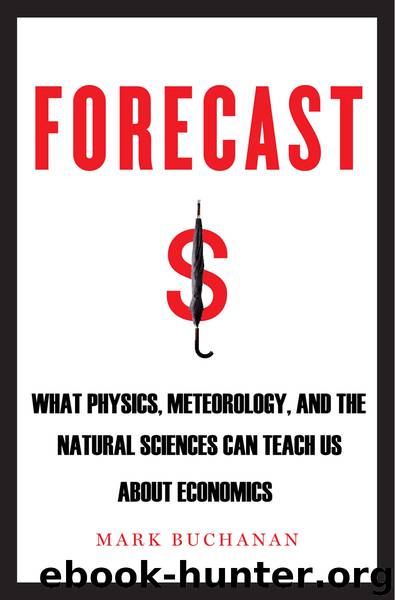Forecast: What Physics, Meteorology, and the Natural Sciences Can Teach Us About Economics by Mark Buchanan

Author:Mark Buchanan
Language: eng
Format: mobi
Tags: science, economics
Publisher: Bloomsbury USA
Published: 2013-07-15T07:00:00+00:00
The Ecological Perspective
Wall Street professionals and smart investors take pride in their ability to see the likely consequences of events. If a cruise ship sinks off the coast of Italy, what does this mean for the stock of the company owning it—or their direct competitors? If the European Central Bank opens discussions with Greek authorities about a possible bailout, how will this affect the price of gold, or the values of Italian, French, or Portuguese bonds? Some people have real skills in such matters, the ability, like chess grand masters, to pick up on subtle clues learned through long experience and study. Even so, the possibility of calculating the ultimate consequences of one or several events is probably vastly overestimated; the number of pathways along which influences can travel is too great.
Two decades ago, ecologist Peter Yodzis made a profound argument to this effect in the context of ecological food webs. Seals eat cod. So, if there were fewer seals—perhaps the result of a cull designed to help the fishing industry—there should be more cod. Or so you’d think. But seals also eat hake, for example, another fish species, and a direct competitor of cod. Hence, fewer seals should also mean more hake, and more competition for cod. Both effects need to be counted, and, as Yodzis showed, this is only the beginning. Looking at the structure of real food webs, and including “paths” (little chains of cause and effect like the one described here) involving four species or less, Yodzis found more than 225 million different interfering influences. A simple and convincing story of how A will affect B, causing C and in turn D, really presents a profoundly incomplete view. This one causal pathway actually counts for little in the face of a profusion of similar causal pathways that could be just as influential.
It is the comparable complexity of such networks of interdependence in finance and economics that will almost certainly demand the use of computer models as experimental tools to study feedbacks within complex ecologies of interactions. The minority game, both the simplest version and its many extensions, illustrate what’s possible when looking at markets from a systems perspective. It already reveals the existence of a profound phase transition—between predictable and unpredictable, or “liquid” and “frozen”—that has never before been anticipated by equilibrium theories. But similar models treating markets as ecologies of interacting beliefs and strategies can also be put to practical use.
About fifteen years ago, executives at the NASDAQ stock exchange had plans to drop its historical use of fractional prices and to change to a modern decimal format. They expected that changing the “tick size” of prices from 1/16th to 0.01 would lower the bid-ask spread, and encourage more business to the exchange. Before going ahead, however, the company hired scientists to test the idea in a market model inspired by the minority game—a variant closely styled after the NASDAQ exchange details. The model included market makers as well as traders of many sorts, operating
Download
This site does not store any files on its server. We only index and link to content provided by other sites. Please contact the content providers to delete copyright contents if any and email us, we'll remove relevant links or contents immediately.
International Integration of the Brazilian Economy by Elias C. Grivoyannis(74381)
The Radium Girls by Kate Moore(11615)
Turbulence by E. J. Noyes(7693)
Nudge - Improving Decisions about Health, Wealth, and Happiness by Thaler Sunstein(7237)
The Black Swan by Nassim Nicholas Taleb(6758)
Rich Dad Poor Dad by Robert T. Kiyosaki(6172)
Pioneering Portfolio Management by David F. Swensen(6072)
Man-made Catastrophes and Risk Information Concealment by Dmitry Chernov & Didier Sornette(5641)
Zero to One by Peter Thiel(5486)
Secrecy World by Jake Bernstein(4387)
Millionaire: The Philanderer, Gambler, and Duelist Who Invented Modern Finance by Janet Gleeson(4088)
The Age of Surveillance Capitalism by Shoshana Zuboff(3979)
Skin in the Game by Nassim Nicholas Taleb(3964)
The Money Culture by Michael Lewis(3840)
Bullshit Jobs by David Graeber(3825)
Skin in the Game: Hidden Asymmetries in Daily Life by Nassim Nicholas Taleb(3719)
The Dhandho Investor by Mohnish Pabrai(3559)
The Wisdom of Finance by Mihir Desai(3522)
Blockchain Basics by Daniel Drescher(3325)
